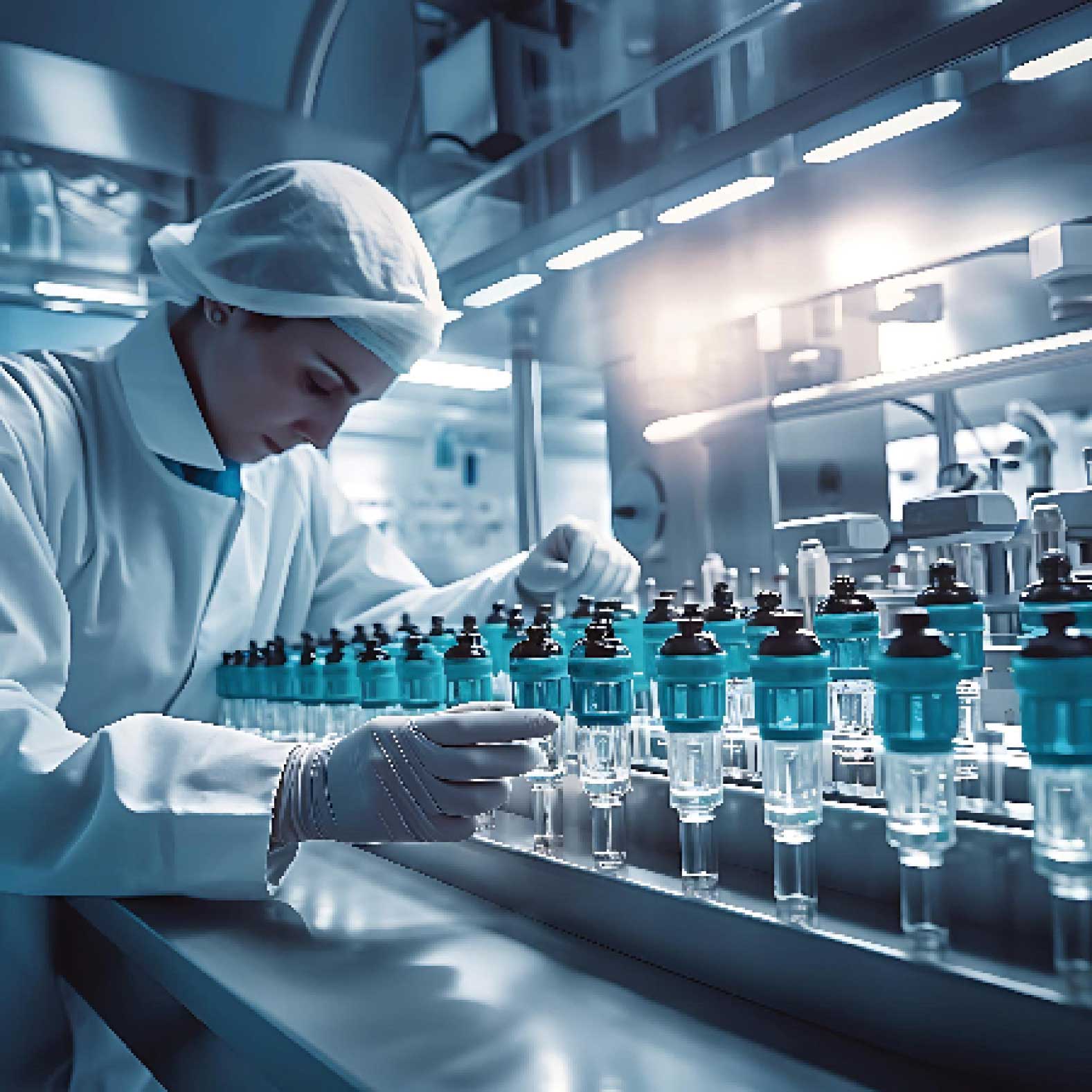Biopharma Industry in India: Growth and Possibilities
August 05, 2024 | Monday | Features
A Report by Cactus Communications, written by Dr H. S. Sudhira, Director, Gubbi Labs
The Indian economy has seen significant growth over the past few years and is poised to grow at a rate of 7% over the next two years[1]. The BioEconomy sector in particular, has shown immense promise. Over 2020, the Indian BioEconomy sector registered an impressive growth of 14.1%, which accounts for about 2.6% of India’s GDP. The sector was valued at $80.12 billion in 2021, increasing from $70.2 billion in 2020[2].
As one of the largest suppliers of low-cost drugs and vaccines worldwide and home to over 5,000 startups, the Indian BioEconomy sector is poised to reach a value of $300 billion by 2030[3]. India is among the top 12 hubs of biotechnology worldwide, and the third largest destination for biotechnology in the Asia Pacific region. India's biotechnology industry covers several areas, such as biopharma, bio-services, bio-agriculture, bio-industry, and bioinformatics.
According to the India BioEconomy Report of 2022, the biopharma segment is the largest contributor to the biotechnology industry in India, with a market share of 49% and total economic contribution of approximately $39.4 billion in 2021.
The ever-growing pharmaceutical industry in India produces a range of drugs and formulations, including generic drugs, branded generics, over the counter (OTC) products, active pharmaceutical ingredients (APIs), and contract research and manufacturing services (CRAMS). The industry is also a major exporter of drugs and formulations to several countries, especially emerging markets. According to IBEF[4], this industry is witnessing a surge in innovation and research activities, especially in the areas of new drug discovery, novel delivery systems, biosimilars, and vaccines.
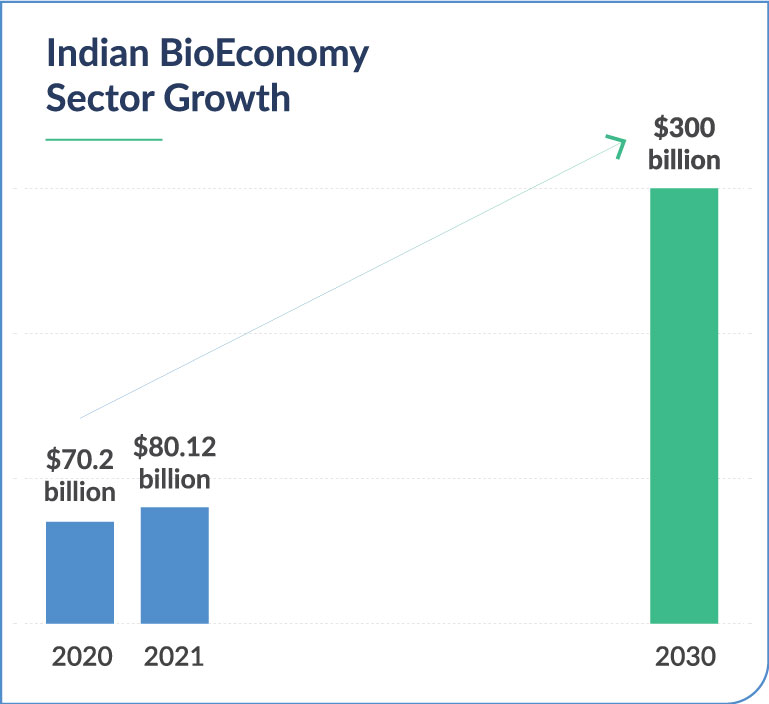
In particular, the biopharma segment develops products such as therapeutics, vaccines, and diagnostics. Of these, diagnostics alone account for 52% ($20.4 billion) share of the total biopharma market, while therapeutics segment account for 26% ($10.3 billion). The vaccine segment (excluding COVID-19 vaccines) account for the rest (22%, at $8.7 billion).
The COVID-19 pandemic has had a significant impact on the sector, leading to changes in the dynamics of production capabilities and trade. Prior to the pandemic, the European Union (EU), the United States of America (USA), and India were leading vaccine producers. While vaccines produced by the EU cater largely to economically advanced nations, the US vaccine production served its domestic requirements. In contrast, India supplied vaccines primarily to the economically developing nations.
Although India’s export volumes accounted for about a quarter of the global exports, in terms of value, they amounted to less than 2%. These figures can be attributed to India’s focus on producing vaccines at affordable prices and supplying them to developing and low-income countries, as per the India BioEconomy Report. However, India remains the largest vaccine producer only second to the EU, with annual production capacities of around 14.5 million kgs—comparable with that of the EU’s annual production capacities, of around 15.5 million kgs.
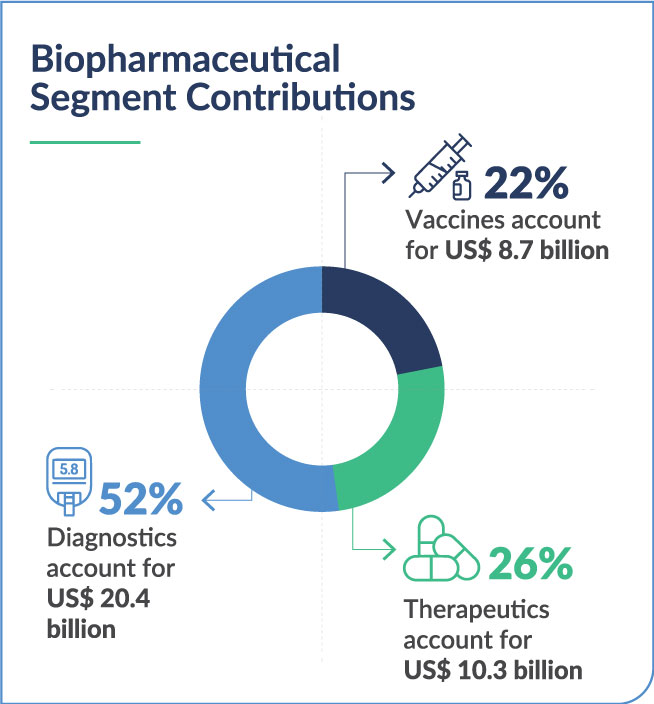
Moreover, the Indian in-vitro diagnostics market is one of the leading sub-segments in the diagnostics sector. Its performance has risen owing to factors such as the high prevalence of chronic diseases, increasing use of point-of-care (POC) diagnostics, and rising awareness and acceptance of personalised medicine and companion diagnostics[5].
The biotherapeutics segment is estimated to record higher growth, with diabetes, oncology, infections, and cardiology medication as the primary contributors. With increasing acceptance to Indian made biosimilars in developed markets like the USA, the likelihood that more nations will accept them is higher. Additionally, an increase in the demand for cost-effective biosimilars is poised to grow rapidly.
The medical device industry is yet another key segment of the biopharma industry in India. It develops products such as surgical instruments, implants, diagnostic equipment, consumables, and digital health solutions.
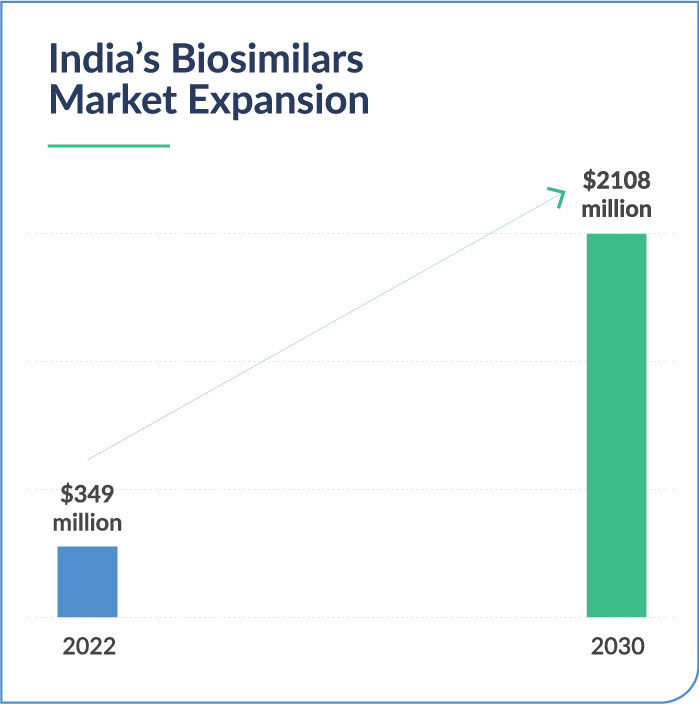
According to IBEF, the medical devices industry in India was valued at $11 billion in 2020 and is expected to reach $50 billion by 2025⁵.
Drivers of Growth in Indian Biopharma
The biopharma industry in India has emerged as one of the leading exporters of generic medicines globally. This has been consistently recording a double-digit growth year-on-year with very impressive market outlook. This rapid growth can be attributed to multiple factors including skilled workforce to government support and extensive research and development activities.
India boasts a large workforce of English-speaking scientists and researchers. These professionals, possessing strong capabilities in chemical synthesis and process optimization, play a crucial role in driving research and development activity in the biopharma industry.
The biopharma industry is also witnessing a rise in innovation and entrepreneurship, with several start-ups developing cutting-edge technologies and solutions for healthcare needs. The increasing demand for quality healthcare, rising disposable income, growing medical tourism, and favourable government policies are some of the factors responsible for this industry’s growth.
The Government of India (GOI) has been upping the ante with key policies, increased budgetary allocation to the sector, and providing a favourable ecosystem at large for this sector. For instance, in the Union Budget 2023–2024, the Department of Biotechnology (DBT) was allotted $162.7 million (Rs 1,345 crore) to support R&D activities in biotechnology. The DBT also implements various programmes and initiatives to foster innovation, entrepreneurship, and collaboration in biotechnology, such as Biotechnology Industry Research Assistance Council (BIRAC), Biotechnology Ignition Grant (BIG), and Grand Challenges India (GCI)[6].
With an aim to promote domestic industries, the DBT has been providing incentives and formulating schemes for the manufacturing of critical bulk drugs, pharmaceuticals, and medical devices. For instance, the Production Linked Incentive (PLI) Scheme for Bulk Drugs and Pharmaceuticals offers financial incentives to eligible manufacturers of identified products for six years[7]. The Scheme for Bulk Drug Parks provides grants-in-aid to states for developing common infrastructure facilities for bulk drug manufacturing units.
Furthermore, the GOI has taken steps to create a conducive regulatory environment for the biopharma industry. To this end, it has appointed the Central Drugs Standard Control Organization (CDSCO) as the national regulatory authority for ensuring the safety, efficacy, and quality of drugs and medical devices in India. The CDSCO has streamlined the approval processes and timelines for clinical trials, new drugs, and medical devices, and has introduced provisions for fast-track approval of certain categories of products. The CDSCO also collaborates with other regulatory agencies and international organisations to harmonise the standards and guidelines for the biopharma industry.
India’s demographic dividend is also at play here. Given a projected ageing population and the government has been continuously focusing on improving healthcare infrastructure with increased spending on healthcare. Added to this, increasing life expectancy has also boosted the demand for pharmaceuticals and therapies within domestic markets too.
The biopharma sector is undergoing a change, moving from recombinant proteins and antibodies to more intricate cell and gene therapies. In order to be globally competitive, a symposium[8] was held in 2021 that was jointly organised by the US Pharmacopeia (USP), the DBT, and the Confederation of Indian Industry (CII). It noted that biomanufacturers must strive to meet international standards in terms of drug quality, decrease production mishaps, and expedite the process of bringing drugs to the market. A panel of experts from academia, manufacturing, and governmental agencies identified several drivers needed for capability building, including a skilled workforce, public–private partnerships, advanced manufacturing technologies, novel biologics, and favourable policies.
In summary, the biopharma industry in India is a key contributor to the economic growth and social development of the country. It offers several opportunities for investment, collaboration, and innovation for both domestic and foreign players. It also plays a vital role in addressing the global challenges of health security, pandemic preparedness, climate change, and sustainable development.
This report attempts to bring out the drivers of growth of the Indian biopharma industry and capture the trends in technology. The role of international partnerships through collaborations and sharing of scientific and manufacturing expertise will be elaborated in the subsequent sections, in addition to the foreign direct investments and partnerships.
The report concludes with a note on the potential growth and prospects of the biopharma industry in India, highlighting the key challenges and how with support from the government and international collaborations, the industry can overcome them.
[1] India economic outlook | Deloitte Insights
[2] India_Bioeconomy_Report_2022.pdf (birac.nic.in)
[3] Biotechnology Industry in India – Biotech Sector Analysis (investindia.gov.in)
[4] Pharmaceutical Companies in India, Indian Pharma Industry- IBEF
[5] Cytiva sets up manufacturing facility for biopharma industry | The Financial Express
[6] Indian Biotechnology Industry Analysis Presentation | IBEF
[7] Government Scheme for Pharmaceuticals Manufacturing | Invest India
[8] Biopharmaceutical Industry Capability Building in India: Report from a Symposium | Journal of Pharmaceutical Innovation (springer.com)

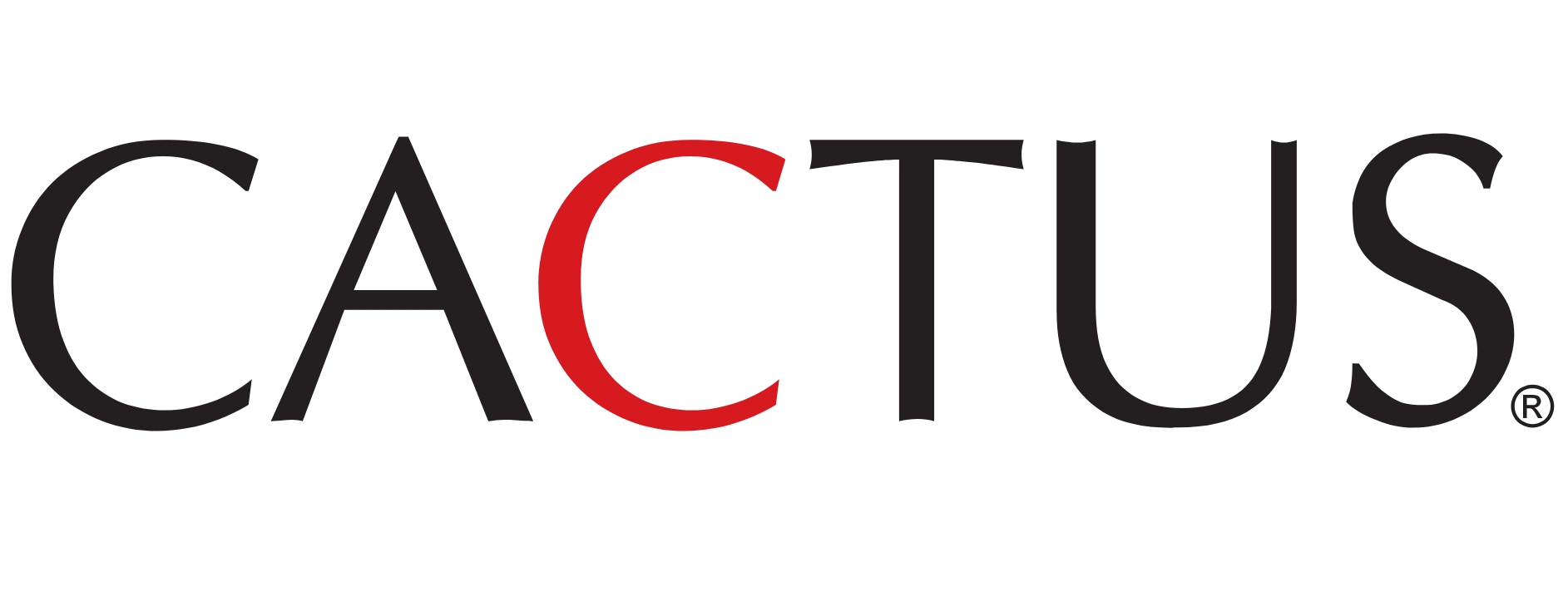
About Gubbi Labs
Gubbi Labs is a private research collective that works on various domains ranging from sustainable ecosystems to liveable settlements. As part of its science communication initiative, it runs Research Matters, a multilingual science news portal.
About Cactus Communications
Cactus Communications is a science communication and technology company, accelerating scientific advancement by making science globally accessible.
Click here for the next part of the report- Trends in Technology


